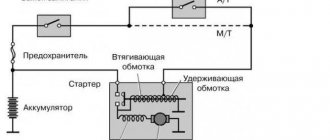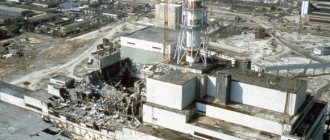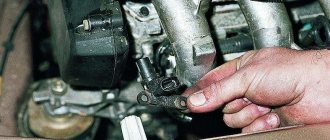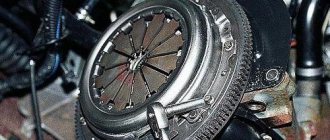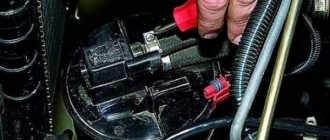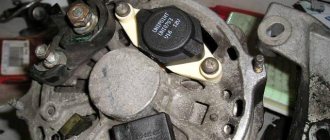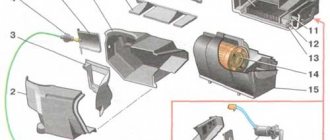I decided to try removing the catalyst from the factory exhaust manifold. A friend in a Priora also had it removed from the standard manifold; I knew roughly how this thing would look and work in its final form. I’ll say right away - it’s not loud, but there is a certain whistling, not a whistling, not a ringing, but something like that, probably due to the fact that there was an empty volume of this very “can” where the catalyst was located. Sometimes you could hear the rear can, as if there was now not enough bandwidth.
I thought it would be “much better” after removal - not really! Honestly, I didn’t feel anything, I thought it would drive better (after the sharp contrast of chip tuning), maybe the catalyst was already clogged after 68,000 km, but the car didn’t see 92 gasoline at all. In short, I wanted to delete it, but I wasn’t sure what would be better.
I didn’t remove the collector, I didn’t even remove the protection - there was no need. I drilled it out using a drill and a long drill bit (fortunately, my grandfather has a reasonable supply of all this stuff)
After I removed the entire catalyst, I was even a little upset. - WHY?! - Yes, because it was literally new.
But again, guided by the laws of physics, the removal brought a certain positive aspect, because any obstacle to the passage of air (exhaust gases) is not good.
And, yes, in the garage while the car was running I felt a sharp contrast - the supply of exhaust gases became more noticeable.
Catalyst (Priora): description, characteristics and reviews
The design of the exhaust gas exhaust system of absolutely all modern cars requires the presence of a catalytic converter (catalyst). This is a prerequisite for complying with environmental regulations.
VAZ-2170 is no exception. Its exhaust system is also equipped with a catalytic converter. This is what we will talk about in this article. We will look at how the catalyst (Lada Priora) works, and also talk about the problems that arise when it malfunctions. In addition, we will try to figure out alternative devices used to replace it.
Design Features
How does the catalyst work? "Priora" in terms of its design is no different from other modern cars. The part consists of a steel body (can) and a working element - metal honeycombs, the surface of which is coated with an active substance that promotes heating of the exhaust. The latter is a platinum-iridium alloy.
Unburned harmful impurities, passing through the honeycomb of the device, settle on the surface of the catalytic layer and, under the influence of high temperature, continue to burn, oxidizing almost completely. As a result, at the output we have an exhaust with a minimum amount of harmful substances.
Priora catalytic converter: design features and purpose
Many people do not delve into the specifics of the functioning of devices such as catalysts, so when asked about their purpose, there is a simple answer - they are needed in order to reduce the amount of harmful emissions into the atmosphere (by 90-95%). Of course, this answer is correct, but how does this process occur?
To easily understand the purpose of the catalytic converter on Priora and other modern cars, you need to know the following information:
- Such a device serves to reduce toxic emissions into the atmosphere, which is achieved by separating nitrogen and oxygen from oxides. The design promotes the afterburning of carbon monoxide, as well as unburned hydrocarbons in the combustion chamber.
- This device is called a catalyst for the reason that in chemistry this is the name given to substances that help accelerate and form chemical reactions. These substances are different types of precious metals, ranging from copper to expensive components: gold, rhodium, palladium and others.
- When fuel assemblies are burned in the combustion chambers, exhaust gases enter the exhaust manifold. The composition of these gases is very different, and it depends directly on the ratio of fuel and air. The exhaust contains both substances that are absolutely harmless to the environment (nitrogen, water and carbon dioxide), as well as toxic, carcinogenic and very dangerous components for humans and the environment. These include: hydrocarbons, nitrogen oxides and carbon monoxide. Catalysts are used to prevent these hazardous components from entering the atmosphere.
The catalytic converter on Priora and other cars does not work immediately after starting a cold engine, but after some time until the honeycomb ceramic structure warms up (there are also metal structures that are more efficient and shock-resistant). Priora cars use elements with a ceramic base.
Their main advantage is their reduced cost compared to metal fillers. These honeycombs are coated with precious metals: rhodium, palladium, platinum, gold, etc.
In simple terms, when harmful substances pass through the catalyst honeycomb present in the exhaust, they are neutralized or rendered harmless:
- unburned fuel particles burn out on the honeycomb;
- platinum and palladium reduce the amount of unburned fuel and carbon monoxide by burning them;
- platinum and rhodium reduce nitrogen oxide emissions;
- Carbon oxides react with unburned oxygen, thereby forming carbon dioxide.
All these processes taking place inside the device contribute to changes in the composition of the exhaust gases. At the outlet, with a working catalyst, the exhaust gases consist of water, carbon dioxide and nitrogen.
Interesting! Chemical reactions occur only at high temperatures (about 700-900 degrees). That is why, at the moment the engine starts and before it warms up, a certain amount of harmful substances enters the atmosphere.
Signs of a bad catalytic converter
The declared service life of the VAZ-2170 catalyst is 140 thousand kilometers. However, this does not mean that after this mileage the device needs to be changed. It can last much longer, or it can fail even after traveling 10 thousand km. It all depends on how you use the car.
How do you know when it's time to change the catalyst? "Priora", being a car stuffed with various sensors, will first of all let you know about this with a burning CHECK light on the dashboard (when reading the code, error 0420). Failure of the catalytic converter is also accompanied by:
- difficult (long) process of starting the engine;
- reduction in power characteristics;
- increased fuel consumption;
- floating speed at idle;
- uncharacteristic sounds of a running engine;
- pungent (acrid) smell of exhaust gases.
What signs indicate that the catalyst has failed on the Priora?
A failed catalyst on a Priora leads not only to the release of harmful and toxic substances into the atmosphere, but also to other unpleasant manifestations. These include:
- Deterioration of the dynamic characteristics of the engine. The car begins to “stupid”, traction from the bottom disappears, slowly picks up speed and starts poorly. The driver may also notice signs such as the inability to reach high speeds (above certain values, usually up to 3 thousand rpm).
- Engine operation changes. This is manifested by the fact that the gasoline engine begins to work like a diesel engine.
- Increased vibrations of the internal combustion engine, as well as characteristic ringing and rattling of the exhaust system.
- When gas is released, small particles or gray dust fly out of the exhaust pipe. These are the components of the catalyst honeycomb.
- Errors on the BC or when reading ELM327, which indicate a malfunction of the second lambda probe. Here is a list of these errors. However, they are an indirect sign that the catalyst has failed.
- Increased fuel consumption.
- The exhaust pipe may turn red, which is clearly visible in the dark.
- Acrid smell from the exhaust pipe.
- Difficulty starting the engine. It may stall at idle.
The reasons for all the above-described manifestations are a decrease in the exhaust gas throughput. Coming out of the engine exhaust system, they accumulate in the catalytic converter housing, which leads to the formation of increased pressure. Due to the fact that the exhaust gases have nowhere to go, the engine cannot operate at full capacity. He begins to “suffocate” in his exhaust gases, which is where the corresponding symptoms arise.
It is also worth paying attention to the mileage of the car. On Priora, catalytic converters usually last for at least 100 thousand km. Problems with them begin after 120 thousand kilometers. However, everything depends on various factors, and if the car is used for driving short distances, and at the same time it starts up every day and warms up for a long time, then signs of a catalyst malfunction may appear much earlier.
Interesting! A faulty catalyst cannot be repaired. If it is unusable, it should be replaced or removed (we will discuss this in more detail below). An old catalyst does not need to be specially disposed of, since such devices are bought by “hunters” for precious metals.
Start with the sensor
If you notice the above signs, do not despair immediately. A faulty oxygen sensor (lambda probe) may also be to blame for the fact that the car has lost its former agility. By the way, Priora has two of them: control and diagnostic. The first is designed to determine the amount of oxygen in the exhaust gases, and the second is to promptly inform the driver about a possible malfunction of the first device.
Often these sensors are called by other people's names, for example, asking how many catalysts are in the Priora and which ones. This is fundamentally wrong. There is one catalyst, two sensors. Let's get back to them.
Considering that the diagnostic lambda probe rarely fails, check the catalyst control sensor first. In the event of a breakdown, the Priora will also notify you with a lit CHECK lamp. All that remains is to read the error code with the scanner and decipher it. If it turns out that there is a problem with the lambda probe, you are in luck.
Smokes after removing catalyst
The catalyst is replaced if it fails and prevents the engine from operating normally. Typically, increased smoke is observed on cars with a faulty converter installed, and after removing the CN, the smoke disappears. However, car owners often complain that the car smokes even after removing the catalyst. There may be several reasons for this phenomenon:
- the firmware has not been re-flashed, and the “fake” has not been installed after removing the CN;
- there is a malfunction in the ECM (one of the sensors does not work), there are problems with the control unit itself;
- piston rings stuck;
- The ignition timing is not adjusted (it is set too late).
How to check the catalyst
The catalytic converter can be checked in two ways: by visually inspecting it and by measuring the pressure inside the can. In the first case, the device is dismantled and a visual inspection is carried out. If the body of the device has traces of mechanical impact, and the honeycombs visible through the holes are melted, the catalyst is clearly faulty.
PRIORA — we knock out the catalyst and get chipped! Is there any reason?
PRIORA
— knock out
the catalyst
and get chipped! Is there any reason? You will see all this in this video! Subscribe...
REMOVAL THE CATALYST AND SIGNS OF A CLOGGED CATALYST IN VAZ, LADA
REMOVING THE CATALYST
AND SIGNS OF A CLOGGED
CATALYST
FOR VAZ 2110, 2111, 2112, 2114, 2115, LADA
PRIORA
, ...
The pressure inside the device can is checked using a special pressure gauge screwed in instead of the control sensor. The engine is started, warmed up and brought to 3 thousand rpm. If the catalyst is working, the pressure should not rise above 0.3 kgf/cm2.
What is a catalyst and how does it work?
Exhaust gases are waste products from engine operation.
It consists of many toxic chemical compounds that cause serious damage to human health and nature. A catalyst is a device that levels their concentration to a minimum value. It is built into the car's exhaust system between the engine and the muffler.
The catalyst consists of three main parts:
- Filter element or media . It consists of honeycomb cells in which, at high temperatures, neutralization (combustion) of harmful gases and fuel residues occurs.
- Thermal insulator . Necessary to maintain the required temperature inside the device.
- Metal casing with ventilation perforation . Protects the product from inadvertent contact with a hot device.
The operation of the catalyst is monitored by sensors. The first of them is located before the neutralizer. It records information about the amount of unburned fuel in the exhaust gases. Another sensor monitors the quality of exhaust gases at the outlet of the catalyst. Information from the sensors is transmitted to the engine ECU, which regulates the fuel supply.
Over time, the honeycomb structure of the catalyst becomes clogged and the device ceases to fulfill its purpose. Next we will look at the main signs of a clogged catalyst.
Why does the catalyst fail?
The main malfunction of the catalytic converter is cell obstruction. Over time, their working layer burns out, and they themselves begin to melt, turning into a solid mass. This creates an obstacle to the free exit of exhaust gases, which is why, in fact, the engine “chokes.”
Premature failure of the catalyst can be caused by:
- use of low-quality fuel;
- oil getting into the fuel;
- irregularities in the ignition system.
Fuel consumption after catalyst removal
Many car owners often ask the question: can fuel consumption increase after removing the catalyst? If the catalytic converter was simply cut out, the lambda probe installed after the catalyst insert will signal an error and the ECU will put the fuel system into emergency mode:
- the engine will lose power;
- fuel consumption will increase.
But car repair workers have learned to cheat the system - they reflash the control unit and remove the second lambda probe from the circuit. The electronics “believes” that there is no second sensor in the system, so error information does not appear, and the internal combustion engine operates normally. With the “trick”, fuel consumption after removing the catalyst is almost the same as with a catalytic converter, the only difference is that the emission of toxic substances into the atmosphere with the removed CN increases.
We change the catalyst on a Priora with our own hands
To replace the VAZ-2170 catalytic converter, it is not necessary to go to a service station. This can be done in your own garage. For this you will need:
- a set of keys;
- head 13 with handle;
- pliers;
- slotted screwdriver.
Replacing the catalyst (Priora) is carried out as follows:
- We install the car on the inspection hole.
- Raise the hood and disconnect the negative terminal on the battery.
- Remove the decorative casing of the power unit.
- We go to the inspection hole. Unscrew (not completely) the lower nut of the clamp connecting the main and additional mufflers. Unscrew the top nut completely. Remove the clamp and remove the O-ring.
- Use pliers to bend the antennae of the catalyst's thermal protective shield.
- Unscrew the three nuts securing the exhaust pipe flange and the catalytic converter flange. Remove the locking plate.
- We lift the additional muffler up and remove its bracket from the front cushion of its suspension (rubber band).
- Disconnect the exhaust pipe of the additional muffler from the catalyst studs. Remove the sealing gasket.
- Disconnect the wiring harnesses from the connectors of the control and diagnostic oxygen sensors.
- Remove the sensor wire holders from the heat shield of the steering mechanism.
- Using a 13mm socket, unscrew the bolts securing the catalyst to the bracket.
- Unscrew the three nuts securing the steering heat shield. We dismantle the screen.
- Unscrew the two nuts of the water pump pipe bracket. Remove the bracket.
- We dismantle the catalyst by unscrewing the eight nuts securing it to the cylinder head. Remove the catalyst and sealing gasket.
- We install the new catalytic manifold in the reverse order.
Approximate price
A new catalytic converter for a Lada Priora can be bought for 7,000-10,000 rubles . Approximate prices depending on the auto part manufacturer:
- FortLuft - from 7,000 rubles.
- AvtoVAZ - from 7500 rubles.
- ASSO – from 10,000 rubles.
- Bosal - about 9,000 rubles.
A used original spare part can be bought for 2500-3000 rubles . Non-original old car parts are sold at prices ranging from 2000 to 2500 rubles .
Is there an alternative
Will Priora work without a catalyst? Of course it will be! The absence of a catalytic converter will not affect its performance in any way, as some “experienced” craftsmen claim. Yes, the car will no longer meet established environmental standards, but it will not work any worse.
If you don’t want to spend money on a standard catalyst, you can always buy a universal device, which will cost you half the price, taking into account installation. Essentially, it is the same catalytic converter with the same functions and similar design. And they are produced mainly in the same factories as the original ones, and their price is lower due to the absence of various trade markups.
Well, if you want to easily tune your Priora, buy a good flame arrester for it. It is installed instead of a catalyst. With it, the engine power will increase due to improved exhaust gas flow, and the sound of the power unit will acquire sporty notes.
Advantages and disadvantages of installing a flame arrester
The installed catalyst for Priora served as a cleaning filter element. The flame arrester exclusively reduces the temperature of the exhaust and prevents strong noise during its passage. Therefore, problems are possible during maintenance. Although in most cases the system and its compliance with European regulations are not checked.
Re-equipment of the exhaust system will free the owner from high costs in the future. Since the Priora catalyst insert is no longer required. And the car will work efficiently and reliably. And carrying out special diagnostics of the exhaust system will become optional.
There is also a more loyal method that does not require changing the design of the exhaust system. To avoid the need to remove the catalyst on the Priora, you can reflash the control system and set reduced demands on the quality and composition of the exhaust gases.
The work should be carried out by specialists, since independent flashing is not always possible. The updated Priora will not be so “demanding”, however, the owner will still have to carry out subsequent replacements of the catalyst.
Constant blockages and the need for regular cleaning force people to seriously consider the pros and cons of removing the catalyst. Even if you are trying your best to preserve natural resources, you will probably be very confused by the cost of a new device. According to intelligence data, an analog catalyst will cost $500.
Drivers who were interested in the question compared the cost of the original with the price of a Zhiguli - not new, but on the move and without the need to urgently change or restore anything. For most budgets this is a pain. While the catalyst can be cleaned, they are rarely thrown away. But only a few agree to invest so seriously in a new one.
The pros and cons of catalyst removal have been assessed from all angles. Alternative options were also considered. Let's see what our researchers came to.
A few words about “spiders”
There is another option for tuning, which involves completely reworking the exhaust system. It is called “direct flow”. Its essence is to remove from the system all elements that prevent the free exit of exhaust gases, including the catalyst.
The main part of the forward flow is the insert (“spider”). This is an analogue of the exhaust manifold, differing from the latter by a special connection of pipes, in which the exhaust gases leaving the cylinders have practically no effect on subsequent exhausts.
Two types of spiders are installed on Priora: 4-1 and 4-2-1. The numbers indicate how the manifold pipes are connected. The catalyst insert (Priora) 4-1 provides for the connection of four pipes into one. In the “spider” 4-2-1, the collector pipes are first combined into a pair, and then converge into one.
It is believed that the optimal pipe connection for the VAZ-2170 is scheme 4-1, but the other is no worse. It is important that the fastening elements of all parts of the exhaust system match, because in addition to the insert, you will also need to purchase a resonator and a muffler.
Flashing after removing the catalyst
When a faulty catalyst is removed from a car’s exhaust system, the car “comes to life” – dynamics appear. In order to remove errors in the ECM (electronic control system), the unit is reflashed for Euro-2. In Russia, such a system still works - environmental standards are not as stringent as in Europe. If the system has only one lambda probe installed on the catalyst (in front of the “can”), flashing the ECU is not required.
How to extend the life of a catalyst
Finally, check out the tips that will help you avoid returning to the topic of replacing the catalytic converter for a long time:
- Do not use low-quality gasoline. This solution will save not only the catalyst. “Priora” is not at all the kind of car into whose tank you can pour anything that burns.
- Do not allow oil to get into the fuel. If you notice that the exhaust has acquired a bluish tint, do not be lazy to check the compression in the cylinders. Parts of the piston group may wear out, causing oil to enter the cylinders.
- Pay attention to the dashboard. If the CHECK warning light comes on and the car has difficulty starting or has lost power, do not delay diagnostics.
The Russian small-class car has not lost its position for ten years now and is one of the most popular domestic models. Each modification of Priora is distinguished by its quality, but at the same time, ease of repair.
Comments
Guests cannot leave comments on the site, please log in.
Products for LADA at the best price
A selection of accessories for LADA from AliExpress
Modern toxicity standards require the use of exhaust gas purification systems. For cars running on gasoline, such a device is a catalyst. Vehicle owners often encounter blockages and the need to clean this part. Purchasing and installing a new element is expensive, so the used part is simply removed. Removing the catalyst has its pros and cons; every driver needs to know them.
A nuance of Lada Priora modification: replacing the catalyst
However, more and more critics and experts agree that the model certainly cannot be called the most reliable, since Priora often has problems with the chassis and exhaust system.
Recently, there has been an increase in cases of car owners complaining about catalytic converter malfunctions. According to statistics, every fourth car breakdown is associated with the “cleaner” of the Lada Priora; therefore, replacing the catalyst does not come as a surprise to the owners. In today's article we will discuss this delicate moment. Let's first define what a catalyst is? So, a catalyst is one of the components of a car’s exhaust system, responsible for cleaning “harmful” gases.
Before the exhaust gases leave the car, they pass through the catalyst system, where through interaction with the ceramic plate, or rather its layer of noble metals, they become environmentally tolerant.
There is no need to talk about the importance of the catalyst once again, especially if you often visit European countries where exhaust concentrations are monitored very closely.
Why does the catalyst clog?
If we exclude cases of the car being involved in an accident or damage to the exhaust system as a result of the bottom hitting an obstacle, then there are three main reasons.
Poor fuel quality. When it burns, the temperature may be higher than permissible. The components of the main element, the carrier, melt and fail. Additives with iron particles added to the fuel neutralize the working surface of the honeycomb. As a result, the chemical reaction stops and the catalyst stops working.
Cell filter clogged. The cells become clogged with soot, soot, etc. This prevents exhaust gases from passing through them.
Causes of failure and replacement of the Priora catalyst 16 valves
Experts identify several main factors that can lead to catalyst failure:
- Impact - yes, the most common impact with the bottom on a stone or curb. It will most likely lead to the appearance of microcracks, which will only increase as the vehicle continues to be used;
- Filling a car with low-quality fuel, as well as using various types of additives (for most types of catalysts, fuel additives are strictly contraindicated).
- Improper care of the catalytic converter, as well as reluctance to carry out routine diagnostics of the element.
What causes the catalytic converter to break down?
There is an established preconception that this device is capricious and short-lived. We would disagree with him: most catalysts (at their price!) are designed for a mileage of 100-150 thousand km. Yes, not every car owner puts so much mileage on his car - at least without changing it. But practice shows that only half of the catalysts can handle the estimated mileage. Their early failure is due to several factors.
- The main reason why the catalyst does not exhaust its service life is low-quality fuel. And sometimes almost all domestic gas stations supply them. In this case, regular cleaning, which many motorists completely forget about, can extend the life of the device;
- The next most common thing that damages the catalyst is water, antifreeze or oil coming into contact with the hot body. This phenomenon is especially dangerous for ceramic (cheaper) versions. From this point of view, it is fundamentally important to maintain the tightness of the system and monitor the formation of condensation;
- Incorrect ignition. If you fail to start the engine the first time, the gasoline that was not used for starting accumulates in the exhaust tract. The next plant causes it to explode in the catalyst. Ceramic honeycombs fly into pieces, metal ones can be deformed;
- The arrival of crushed stone into the catalyst is only dangerous for ceramics, which fly apart from the collision. The metal holds up much better and longer, but numerous head-on collisions gradually deform it more and more, although the body protects against them much more reliably than ceramic honeycombs;
- We can conclude: premature breakdowns are mainly caused by the negligence of the car owner. Even the impact of bad gasoline can be mitigated by care, which in this case will manifest itself in timely prevention.
Replacing the catalyst on a Priora: signs of a faulty mechanism
Any breakdown that was discovered before the “fatal end” is much easier to fix. Therefore, you should always monitor the condition of the “cleaner” and pay attention to the following symptoms:
- A noticeable drop in vehicle power, which is often accompanied by a failure of the power plant to start.
- Sudden changes in engine speed while idling.
- An uncharacteristic rattling sound comes from under the car seat.
- The “Check” signal came on on the dashboard.
Signs of a clogged catalyst
One of the main symptoms of a malfunction is a decrease in engine power and a noticeable deterioration in vehicle dynamics. This is manifested by a noticeable decrease in maximum speed and sluggish acceleration when starting from a stop at a traffic light or when overtaking. There are other signs indicating problems with the catalyst:
- Difficulty starting both cold and hot engines.
- If the unit is severely clogged, a complete failure of the power unit is possible.
- An unpleasant smell of hydrogen sulfide (rotten egg) appears in the exhaust.
- Engine speed spontaneously decreases or increases.
A malfunction of the catalyst may be accompanied by the Check Engine light on the instrument panel.
Rice. 2 – “Contamination and destruction of the catalyst filler”
Diagnostics and replacement of the Lada Priora catalyst
Immediately after contacting the auto repair shop, specialists begin diagnosing the catalyst. It is carried out in several stages:
- Computer diagnostics of the catalytic element.
- External inspection of the catalyst, as well as the exhaust system as a whole.
- Catalyst back pressure measurement:
- The technician removes the lambda installed in front of the purifier.
- A fitting is installed in its place.
- A small piece of brake pipe is screwed to it (experienced craftsmen prefer pipes with cap bolts).
- A hose is put on its free end, which the master pushes into the cabin.
- A special device is connected to it - a pressure gauge, with which the back pressure is measured (a value of up to 0.35 kg/cm3 is considered normal).
- Video endoscopy of the catalytic converter.
- Measurements of temperature indicators of the catalyst using an infrared device.
Based on the diagnostic results, the technician has the whole puzzle of what is happening, and he can make a decision about the further fate of the catalyst. It is worth noting that the client’s solvency plays an important role when making a decision, since replacing a Lada Priora catalyst with an original one from a dealer is quite expensive.
Sound after catalyst removal
Often, after removing the catalyst, engine operation is accompanied by an unpleasant sound emanating from the exhaust system. The cause of this sound may be:
- hollowness inside the can - the ceramics from the catalyst were cut out, and the iron body was welded and simply installed in place;
- the installed flame arrester is of poor quality, it is too “empty”;
- when removing the catalyst, the housing was poorly welded, it is not airtight, and therefore cuts;
- When installing the flame arrester, the elements of the exhaust system were poorly connected.
In order not to redo the work, it is better to immediately install high-quality flame arresters; a simply welded empty can of catalyst will not last long and will cause the car owner a lot of trouble:
- the smell of exhaust gases will enter the cabin;
- an unpleasant sound will appear under the hood;
- The jar will quickly burn out from the high temperature.
Replacing the Priora catalyst with PAUK
Many Priora owners are not satisfied with the performance of the basic catalytic converter and they turn to a car repair shop to replace it with a PAUK. The principle of operation of the PAUK is almost the same as that of a conventional manifold - it also removes gas from the cylinders of the power plant. There are several types of elements, but the principle of their installation is the same:
- The Lada Priora is installed in the “pit”, after which the technician removes the crankcase protection.
- The bolts securing the manifold and catalyst tube are unscrewed and the elements are disconnected.
- In case of partial replacement, the catalyst remains in place; in case of complete replacement, it is dismantled.
- Then the technician lifts the hood and unscrews the exhaust manifold bolts.
- The technician dismantles the base manifold.
- Next comes the installation of the SPIDER.
- The SPIDER is attached to the catalyst, and when completely replaced, to the catalyst's alternative, the flame arrester.
Despite the fact that replacing the Priora catalyst with a Spider does not look very difficult, it is strictly not recommended to undertake it yourself. If any problems are detected, you should immediately seek help from competent specialists.
Types of catalytic converters for Priora: which one is better to choose as a replacement
VAZ-2170 cars are equipped with different types of engines (21114, 21116, 21124, 21126 and 21127). The model range includes both 8-valve and 16-valve engines (all with a volume of 1.6 liters). Depending on the type of engine, the catalysts used on cars differ. The following types of catalysts are installed on Prioras, which have the corresponding part numbers:
- 11183-1203008-00 - installed on 8-valve engines of Priora cars and other brands of cars from AVTO-VAZ. There are two modifications: new and old.
- 11194-1203008-10, 11, 12 and 13 - installed on 16-valve engines of Priora cars.
There are also different modifications of cat collectors for Priora, which were installed on different types of engines, but almost all of them are interchangeable.
Products differ not only in external characteristics, but also in materials and production methods. Various manufacturers offer collectors for Priora, which are made of sheet steel and cast iron. Moreover, steel versions are produced by stamping and welding, and cast iron ones are produced by casting.
Devices such as Delphi and products from the Ural Electrotechnical Plant and others are available for sale. When choosing a new catalytic converter, you need to check the catalog number, which is indicated on the body of the element installed on the car.
It is recommended to select a neutralizer for your car using this number. The price of such products depends on the manufacturer and varies from 2-3 thousand rubles. However, by choosing non-original options, the owner risks that the device will barely last 50 thousand kilometers.
Interesting! When choosing between steel and cast iron products based on the material of manufacture, it is better to give preference to modifications of the second type. They will not only last longer, and you don’t have to worry about the possibility of damage to the case, but they also operate much quieter (they don’t make a loud, unpleasant sound at speeds above 2.5 thousand rpm).
The price of a cast-iron exhaust pipe with a catalytic collector will be more expensive than its metal counterparts, but the driver will enjoy the pleasant operation of the engine.
Below is a diagram of the intake pipe with a catalytic collector and its component parts with their numbers and article numbers, which may be needed when carrying out work to replace products.
Diagram of the exhaust pipe with Priora catalyst
As an alternative to a new catalyst, you can purchase used products from disassembly. Such devices will cost much less, but the most important thing when purchasing is to check the mileage of the car from which the corresponding type of part was removed.
Interesting! On a Priora, the catalyst is combined with the exhaust manifold, so the device is called a catalytic converter or a exhaust pipe with a catalytic converter.
Tips for extending the service life of the Lada Priora catalyst
Of course, wear of the catalytic converter cannot be prevented, but it can be significantly delayed. The following tips and recommendations will help with this:
- Maintaining a diagnostic schedule for the purifier, as well as proper care for it.
- Timely replacement of spark plugs (by the way, you only need to install original elements purchased from official dealers).
- We won’t talk about the importance of using high-quality fuel again.
- The neutralizer does not tolerate sudden temperature changes, therefore, when operating a Lada Priora car with 16 valves, try to avoid this.
In addition, the service life of the catalyst is affected by the quality of the element, as well as the professionalism of the craftsmen who installed it.
To shoot or not to shoot?
So, you are faced with the final failure of the catalyst and the impossibility of resuscitating it. Should I delete the device or not?
- Without it, the quality of the exhaust deteriorates: it begins to meet EURO 2 standards. It is believed that this makes it difficult to undergo maintenance. However, this argument seems dubious to us: catalysts are installed only on injectors, and besides, cars are necessarily electronic. Somehow, Ladas from 1 to 7 models undergo technical inspection;
- The car’s power begins to surpass previous figures, which will be a balm for the owner’s soul.
- We also add lower fuel consumption as a plus. The reduction sometimes reaches 10-15%;
- In terms of cons, the list turns out to be quite impressive. First of all, this is an almost 100% occurrence of errors in reporting and a continuous lighting of the Check engine. Some may be indifferent to this, some will be annoyed by it, but the main thing is that there is a possibility of missing a serious warning about other problems in the car;
- The muffler will work worse. Moreover, it will burn out faster, since exhaust gases with an unacceptably high temperature will begin to break into it. Plus the exhaust will have a loud and unpleasant sound. Fire is likely to appear from the exhaust pipe;
- The engine will become noisier; Vibration is likely to be transmitted to the interior.
In our opinion, the pros and cons of catalyst removal are combined with the predominance of the latter. It will be completely insufficient to simply cut it out: too much is lost. At a minimum, you will need a flame arrester instead of a catalyst. And to remove the constant Check engine reminder, you also need to install a decoy lambda probe like “Stronger”.
Moreover, in many cases, blende is not enough, and the issue has to be resolved by installing a series RC filter. All the work taken together, even if carried out with the participation of auto experts, still turns out to be cheaper (and much!) than a new catalyst. However, before it breaks, it is still better to take care of it so that it lives as long as possible.
Catalyst (Priora): description, characteristics and reviews
The design of the exhaust gas exhaust system of absolutely all modern cars requires the presence of a catalytic converter (catalyst).
This is a prerequisite for complying with environmental regulations. VAZ-2170 is no exception. Its exhaust system is also equipped with a catalytic converter. This is what we will talk about in this article. We will look at how the catalyst (Lada Priora) works, and also talk about the problems that arise when it malfunctions. In addition, we will try to figure out alternative devices used to replace it.
Lada Priora: removing the catalyst at a service station
The design of the Lada Priora uses a collector type of catalyst. That is, it is part of the collector. Our service station technicians have the necessary experience to remove such a neutralizer. All work is carried out carefully, as it is easy to damage other components of the Lada Priora exhaust system.
We highlight several main stages:
- The car must be raised on a lift so that the technicians can gain access to the unit.
- Next, the dismantling of the protection, if provided, begins.
- The bolts on the muffler side are unscrewed. Attention - the fasteners may be rusty, which requires special care.
- The bolts are loosened to secure the housing to the base.
- The next step is to remove the oxygen sensors.
- The nuts securing the system to the block also unscrew. All connections are difficult to reach and may stick.
- After dismantling the structure, you can begin to remove the catalytic converter. The part is knocked out or cut out. We recommend the latter option as it is safer and faster, ideal for Priora.
- When reassembling the system later, we use new gaskets.
- When welding, the seams are treated with heat-resistant paint to prevent rusting.
Weighing all the pros and cons - making a decision
If the device is damaged to such an extent that it no longer performs its functions, the question arises: remove it completely, replace it with a new part, or find an alternative spare part. When cutting, you need to contact qualified specialists who will adjust the noise of the exhaust system, eliminate errors in the program and install protection against burnout of the exhaust pipe.
Replacing the catalyst with a flame arrester
Odor is difficult to eliminate. But the concentration of harmful substances in a car with a small engine volume is much lower than with a volume of 4–5 liters. If you are sensitive to it, you should choose to install a new device. To increase power, you can install a direct-flow exhaust pipe or use a sports converter.
In addition to removing the catalyst, other replacement options must be used.
A flame arrester is a common way to replace a catalytic converter. It is more economical, and a large range of models fits all types of engines. Another way to solve the problem is to install a mechanical blende, followed by installation of an RC filter.
If all necessary operating conditions are met, the catalyst will last quite a long time, and a device that is damaged and clogged with waste must be removed or replaced.
Video on the topic: Removing the catalyst - pros and cons
But many owners note that the Priora catalyst can lead to numerous problems with vehicle operation. Therefore, a practical solution would be to replace it with a flame arrester.
What happens if you don’t remove the Priora catalyst in time?
Failure of a node is always accompanied by a decrease in throughput.
Consequently, there is an obstacle to the passage of exhaust, which is why the engine cannot operate normally. There is a noticeable loss of performance and performance continues to deteriorate. The appearance of chips and cracks in the ceramic matrix leads to further destruction. The broken particles mix with the exhaust. And as a result of high back pressure, they return to the cylinders and cause engine failure. Other vehicle systems also suffer. Therefore, it is worth paying attention to the appearance of signs of malfunction.
